Notes: Little Hulton station was situated on the London & North Western Railway’s (LNWR) Roe Green Junction – Fletcher Street Junction line which opened for goods services on 16 November 1874. The line, which was authorised on 12 July 1869, created a shorter route for the LNWR between Bolton and Manchester and one that could compete more easily with the Lancashire & Yorkshire Railway (LYR) who had a direct route between the two times dating back to 1839. The LNWR Bolton and Kenyon line provided a link between Bolton and Manchester but it was not direct and it was more than twice as long as the LYR route. From 1864 the situation was improved when the LNWR opened a line between Eccles and Wigan from which a connection to the Kenyon line was made at Howe Bridge, but again the route was still longer than the LYR line.
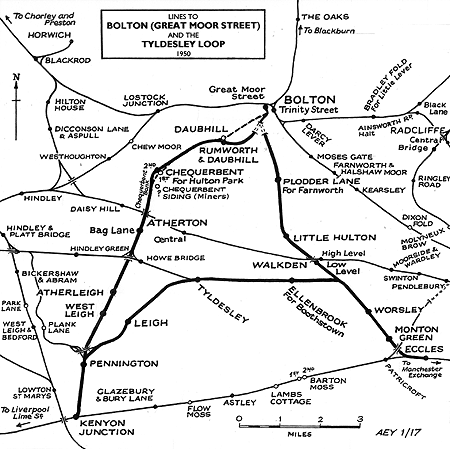 The first sod on the direct line was cut on 23 January 1871 but construction did not start until March 1871. The new line diverged from the Eccles and Wigan line at Roe Green and then ran for 4¾ miles to Fletcher Street in Bolton where it connected to the Kenyon line. Passenger services were introduced on 1 April 1875. Little Hulton opened when the passenger service was introduced along with two other stations (Plodder Lane and Walkden). The first sod on the direct line was cut on 23 January 1871 but construction did not start until March 1871. The new line diverged from the Eccles and Wigan line at Roe Green and then ran for 4¾ miles to Fletcher Street in Bolton where it connected to the Kenyon line. Passenger services were introduced on 1 April 1875. Little Hulton opened when the passenger service was introduced along with two other stations (Plodder Lane and Walkden).
The station was located to the eastern edge of its namesake on the north side of Manchester Road which was a major thoroughfare dating back to Roman times. Manchester Road passed over the line on a brick and iron span bridge. The line was in a cutting at this point and the booking office was at street level on the western side of the line. It was in a small, but smart single-storey brick building under a hipped (pyramidal) slate roof. The two windows and the central door were topped by segmental arches, the door having a fanlight above to bring the opening up to the same height as the windows.
From the booking office a covered footbridge spanned the double-track line and steps connected to the platforms. Both platforms had waiting rooms housed within single-storey buildings. These had hipped roofs, tall chimneystacks and awnings stretching as far as the platform edge.
 Little Hulton lacked goods facilities but half a mile north was Little Hulton Junction from where a branch line connected to Peel Hall Colliery. Little Hulton lacked goods facilities but half a mile north was Little Hulton Junction from where a branch line connected to Peel Hall Colliery.
At the time of opening Little Hulton had 10 trains in each direction on Monday-to-Saturday. Trains ran between Bolton Great Moor Street and Manchester Victoria. The journey time to Manchester from Little Hulton was 31 minutes. Bolton Great Moor Street was reached in 10 minutes.
On 30 June 1884 the Bolton service started to use the LNWR Manchester Exchange station which opened that day.
The December 1895 timetable showed 10 up and 12 down trains on Monday-to-Friday. On Saturday there were two extra up and one extra down services. There was no Sunday service.
On 28 August 1913 Lancashire United Tramways Ltd opened a new route between Walkden Memorial and Clegg Lane. The tramway created a route between Walkden and Farnworth via Little Hulton that ran along Manchester Road and passed the station. The tramway competed directly with the railway for journeys of a more local nature.
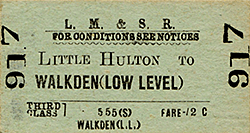 On 1 January 1922 the LNWR absorbed the LYR. The July 1922 timetable showed 13 up and 15 down trains on Monday-to-Friday. On Saturday there were only 11 up services. On 1 January 1922 the LNWR absorbed the LYR. The July 1922 timetable showed 13 up and 15 down trains on Monday-to-Friday. On Saturday there were only 11 up services.
Little Hulton became part of the London Midland & Scottish Railway (LMS) on 1 January 1923.
In 1931 the tramway along Manchester Road was closed and buses replaced the trams.
Being in control of both the former LNWR and LYR routes between Bolton and Manchester the LMS did not need to compete with itself and main line traffic was concentrated on the LYR route. However Little Hulton still enjoyed a good level of service from local trains. By the summer of 1932 there were 15 up and 14 down services on Monday-to-Friday as shown in the table below. On Saturday there were 14 up trains and no services on Sunday.
Up Trains – Summer 1932 |
Destination |
Down trains – Summer 1932 |
Destination |
6.39am |
Manchester Exchange |
6.56am |
Bolton Great Moor Street |
7.34am |
Manchester Exchange |
8.04am |
Bolton Great Moor Street |
8.20am |
Manchester Exchange |
8.34am |
Bolton Great Moor Street |
8.34am |
Manchester Exchange |
9.48am |
Bolton Great Moor Street |
9.24am |
Manchester Exchange |
12.23pm (Saturdays Only) |
Bolton Great Moor Street |
12.24pm |
Monton Green |
12.39pm (Saturdays Excepted) |
Bolton Great Moor Street |
1.34pm (Saturdays Excepted) |
Manchester Exchange |
12.52pm (Saturdays Only) |
Bolton Great Moor Street |
1.49pm (Saturdays Only) |
Manchester Exchange |
1.33pm (Saturdays Excepted) |
Bolton Great Moor Street |
2.19 (Saturdays Excepted) |
Manchester Exchange |
2.03pm (Saturdays Only) |
Bolton Great Moor Street |
2.29pm (Saturdays Only) |
Manchester Exchange |
2.22pm (Saturdays Excepted) |
Bolton Great Moor Street |
3.41pm (Saturdays Excepted) |
Manchester Exchange |
3.50pm |
Bolton Great Moor Street |
4.25pm (Saturdays Only) |
Eccles |
4.50pm |
Bolton Great Moor Street |
4.39pm (Saturdays Excepted) |
Monton Green |
5.53pm |
Bolton Great Moor Street |
5.55pm |
Manchester Exchange |
6.43pm |
Bolton Great Moor Street |
6.49pm |
Manchester Exchange |
7.39pm |
Bolton Great Moor Street |
9.04pm |
Manchester Exchange |
9.19pm |
Bolton Great Moor Street |
10.09pm (Saturdays Only) |
Manchester Exchange |
10.25pm |
Bolton Great Moor Street |
10.24pm (Saturdays Excepted) |
Monton Green |
|
|
11.04pm |
Monton Green (Manchester Exchange on Saturdays) |
|
|
The service was reduced during the Second World War. Although services were increased after the war they did not match those provided in the 1930s. The LMS summer timetable showed eight trains in each direction on Monday-to-Friday. Three of the up trains ran only as far as Monton Green. On Saturday there were an extra up and two extra down services. No trains ran on Sunday.
On 1 January 1948 Little Hulton became part of British Railways [London Midland Region] (BR[LMR]).
The summer timetable showed only four up and three down trains on Monday-to-Friday. On Saturday there were six up and four down trains.
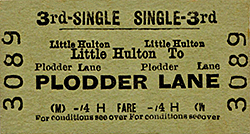 BR[LMR] withdrew the passenger service between Bolton Great Moor Street and Manchester Exchange on 29 March 1954 and the passenger station at Little Hulton closed completely. BR[LMR] withdrew the passenger service between Bolton Great Moor Street and Manchester Exchange on 29 March 1954 and the passenger station at Little Hulton closed completely.
On 20 October 1960 just over two miles of the line were closed between Roe Green Junction and Little Hulton Junction. The line was lifted through the station shortly after.
By the 1970s all trace of the station had been swept away. In 2017 the course of the railway was in use as a footpath/cycleway.
Tickets from Michael Stewart route map by Alan Young
Sources:
- A Lancashire Triangle Part 2 - D J Sweeney, Triangle Publishing 1997.
- A Regional History of the Railways of Great Britain - Volume 10 The North West - Geoffrey O Holt, David & Charles 1986.
- Forgotten Railways - North West England - John Marshall, David & Charles 1981.
- Railway Passenger Stations in Great Britain - A Chronology, by M Quick, RCHS 2009.
To see other stations on the Bolton Great Moor Street - Eccles line click on the station name: Bolton Great Moor Street, Plodder Lane for Farnworth,
Walkden Low Level, Worsley and Monton Green |





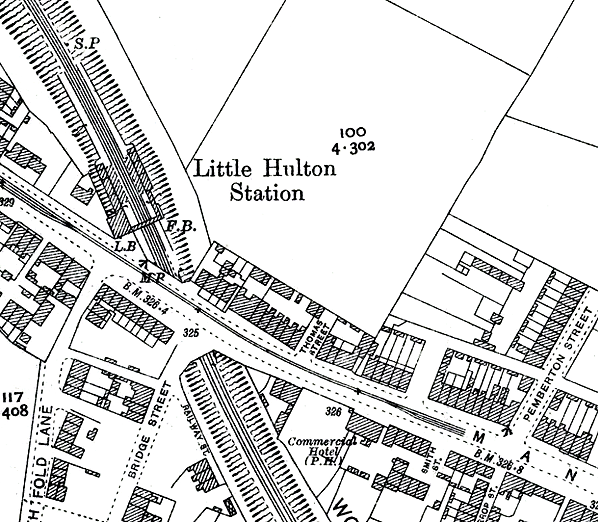


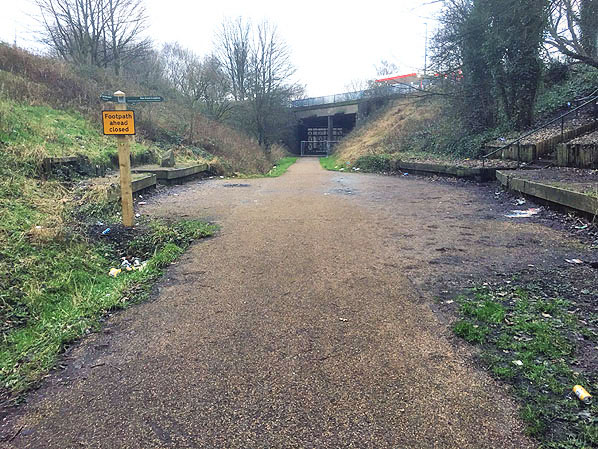 Looking south-east at the site of Little Hulton station on 9 February 2017. The bridge which carries Manchester Road over the line required strengthening at this time (click here to see a photo of it).
Looking south-east at the site of Little Hulton station on 9 February 2017. The bridge which carries Manchester Road over the line required strengthening at this time (click here to see a photo of it).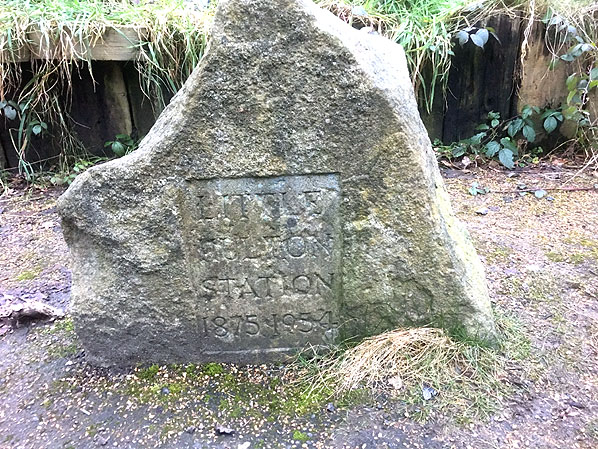
 The first sod on the direct line was cut on 23 January 1871 but construction did not start until March 1871. The new line diverged from the Eccles and Wigan line at Roe Green and then ran for 4¾ miles to Fletcher Street in Bolton where it connected to the Kenyon line. Passenger services were introduced on 1 April 1875. Little Hulton opened when the passenger service was introduced along with two other stations (Plodder Lane and Walkden).
The first sod on the direct line was cut on 23 January 1871 but construction did not start until March 1871. The new line diverged from the Eccles and Wigan line at Roe Green and then ran for 4¾ miles to Fletcher Street in Bolton where it connected to the Kenyon line. Passenger services were introduced on 1 April 1875. Little Hulton opened when the passenger service was introduced along with two other stations (Plodder Lane and Walkden).  Little Hulton lacked goods facilities but half a mile north was Little Hulton Junction from where a branch line connected to Peel Hall Colliery.
Little Hulton lacked goods facilities but half a mile north was Little Hulton Junction from where a branch line connected to Peel Hall Colliery. On 1 January 1922 the LNWR absorbed the LYR. The July 1922 timetable showed 13 up and 15 down trains on Monday-to-Friday. On Saturday there were only 11 up services.
On 1 January 1922 the LNWR absorbed the LYR. The July 1922 timetable showed 13 up and 15 down trains on Monday-to-Friday. On Saturday there were only 11 up services.  BR[LMR] withdrew the passenger service between Bolton Great Moor Street and Manchester Exchange on 29 March 1954 and the passenger station at Little Hulton closed completely.
BR[LMR] withdrew the passenger service between Bolton Great Moor Street and Manchester Exchange on 29 March 1954 and the passenger station at Little Hulton closed completely. 
 Home Page
Home Page